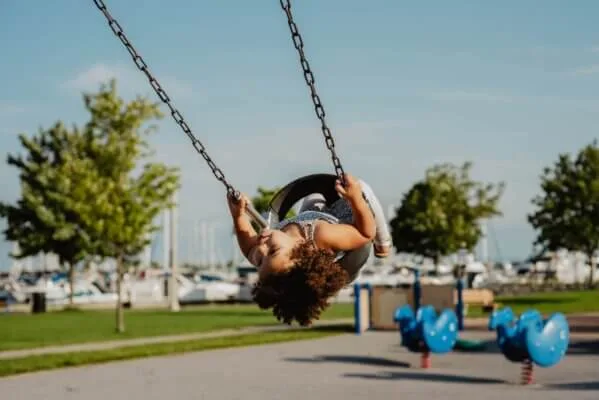
Also known as adventurous play or child-led play, risky play is most simply defined as play that is thrilling and exciting, and that also involves uncertainty, or risk of injury.
MICHIGAN—Parents, are you ready for some risky play?
At first glance, the phrase “risky play” may sound absolutely terrifying. But according to many childhood development experts, it’s a huge part of your kiddo’s healthy development. It helps with emotional regulation, learning risk management and flexing their problem solving muscles.
Also known as adventurous play or child-led play, risky play is most simply defined as play that is thrilling and exciting, and that also involves uncertainty, or risk of injury.
Still sound scary? Maybe a bit anxiety inducing? I get it.
Believe me. I’m a former “helicopter mom.” Back then, you could often find me a fingertip away from my little boy on the playground, following behind him, bracing for a fall. I’m sure he could feel my breath on the back of his neck. He was young, carefree, fearless— and running. Always running, full speed, scaling, jumping. Then there was me, in my big age, out of breath and hovering. I was scared that he would somehow get hurt if I didn’t remove all risks to prevent it.
Over time I learned that it’s not my job to take away all risks. It was my job to help my kiddo learn how to navigate those risks. Because the truth is, sometimes they will fall, or get hurt. But we must teach them how to get back up and adjust. So how do we do that with less anxiety?
Start small, and allow your child’s confidence and your confidence in your little one’s abilities to grow together. It’s not always easy, but here are a few tips that I have found to be helpful:
Head to the playground.

The playground is probably my favorite place for adventurous play. Because it has myriad things to explore right at your fingertips, and it’s relatively controlled. Obstacles like climbing up ladders, and slides to whizz back down; gauging height, balancing skills—it’s all right there.
Resist the urge to yell.
This was a hard one for me. My son has always been a daredevil. When he was learning to climb up the stairs, I found myself constantly blurting: “Be careful!” Running at the park? “Be careful!” Monkey bars? “Be careful!” I didn’t realize the problem until one day I shouted out and startled him, and he fell.
Those words that I thought were a helpful reminder were actually causing him to break focus—and that posed more of a chance that he may get hurt. Or, it could make him afraid.
I stumbled upon this helpful tip from Susie Allison of Busy Toddler, who recommends parents try using more supportive languages to assist children in navigating riskier sorts of situations.

For example, my son and I recently visited the new playscape—and huge new slide— at Lower Huron Metropark. It was ridiculously tall, and I must admit, I was even nervous to climb up.
My son’s eyes lit up. I could tell that he was excited to try it out, but also uncertain. I was prepared to let him go, but also prepared to do whatever necessary to help him if he needed it.
With each step he made. I fought the urge to blurt out that repetitive phrase: “Be careful!”
Instead, I thought about how my language could offer support:
- “How does your body feel right now?”
- “Do you notice that?”
- “Have you thought of your plan to get all the way up?”
- “Would you like some help coming up with a plan?”
- “Let me know how I can support you.”
- “If you don’t feel comfortable, it’s OK to come back down.”
It turns out, it worked. He didn’t take up my offer to come back down. He soared up to the top, and waved. My heart swelled. His confidence grew—all because he assessed the risk, and conquered a fear and now feels comfortable knowing that he can work his way through it.
Now, that huge behemoth of a slide is the first thing he tackles when we go to the park.
Don’t hover.
When you’re in your groove and doing something fun, isn’t it the worst to have someone hovering over you or interrupting? Well, kids around the globe are uttering “same.”
This doesn’t mean don’t watch them. It means watching them from a safe distance. Be close enough to know where they are, but not too close to get in the way of their own adventure.
Too nervous or scared to give them their distance? That’s normal.
The real challenge is not letting our fears get in the way of their ability to learn and function. Experts at the University of Boston suggest using the “17 second rule.” If you start to feel uneasy about how your kids are playing, take a step back and observe them for 17 seconds. Consider: Is it actually dangerous?
Turn everyday tasks into adventures.
With pretty much anything I do around the house, I encourage my son to participate as well—most notably, with cooking. From a very young age, my son has been helping me in the kitchen. We use tools to discuss risks and then use them to build confidence and try new things.
I often delegate the tasks of cracking eggs, and chopping ingredients to him. We discuss safety and where to hold the knives. I even bought a set of child-safe knives for him to use. Usually, I just watch from a safe distance and let him do his thing. When he stirs things on the stove, for example, I simply ask if he is aware of his surroundings, and how the temperature of things feel.
As time has gone on, he has started returning the favor when I’m in the kitchen too. Touche.
Watching his confidence and skill grow in this area has been incredible. And if cooking isn’t your thing, try fixing things around the house or gardening together too. Show your child how to use different tools safely and responsibly. Give them small tasks and watch them take off with them!
Ask questions — constantly.
As parents, we often get a lot of curious questions from our little ones. Dish them right back.
Perhaps you are on a nature walk with your little one. Ask: “What cool things do you notice? Which path should we take?” You venture down close to the water to skip rocks. Lean in, and ask: “What’s interesting about this activity to you?” Helping your little one to ride their bike for the first time? Ask them a question about it: “What part of this do you find challenging?”
I find that the more I engage my little guy in conversation, the more his mind goes to work—and the more he wants to take it a step further, explore, and seek adventure. It builds confidence.

VIDEO: Trump isn’t the only republican facing charges for alleged financial crimes
https://www.tiktok.com/@gandernewsroom/video/7361494909938978090 A whole lot of Michigan Republicans and lobbyists are facing criminal charges for...

VIDEO: It’s expensive to be poor in Michigan
https://www.tiktok.com/@gandernewsroom/video/7361154790300060974 Ever heard of predatory payday loans? Here’s how new laws could help protect...

Here’s everything you need to know about this month’s Mercury retrograde
Does everything in your life feel a little more chaotic than usual? Or do you feel like misunderstandings are cropping up more frequently than they...

The ’Gander wins multiple 2023 Michigan Press Association awards
MICHIGAN—The ’Gander Newsroom has earned multiple awards in the 2023 Michigan Press Association Better Newspaper Contest. The awards were announced...

Michigan Republicans ask Supreme Court to restrict medication abortion access
A lawsuit supported by Republicans could disrupt access to the most common form of abortion—even in Michigan, where reproductive rights are...






